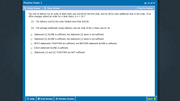
PREP-IV
This topic has expert replies
GMAT/MBA Expert
- [email protected]
- Elite Legendary Member
- Posts: 10392
- Joined: Sun Jun 23, 2013 6:38 pm
- Location: Palo Alto, CA
- Thanked: 2867 times
- Followed by:511 members
- GMAT Score:800
Hi race2mba,
This DS question is a nice example of what's called "a question BEHIND the question."; this idea of finding another way to view the question usually occurs a few times on Test Day and makes those particular questions easier to answer.
The prompt tells us that N chairs were ordered, the first chair cost $10 and each additional chair costs $1.
The question asks "Is N > 24?"
Since we know what 24 chairs would cost ($10 for the 1st, $1 for each additional = $10 + $23 = $33), the question BEHIND the question asks "Did the office manager spend more than $33?"
Fact 1 tells us the order is more than $30...
If it's $31, then the answer to the question is NO
If it's $35, then the answer to the question is YES
Inconsistent answers means Fact 1 is INSUFFICIENT.
Fact 2 is that the average cost of the N chairs was $1.36
This information is fantastic because we don't have to calculate anything. There's only one value of N that will equal $1.36 exactly. If you change the N, then the average changes. Fact 2 would be enough to tell us exactly what N is, so we'd be able to answer the question (and there would be JUST ONE answer). Fact 2 is SUFFICIENT.
Final answer: B (Fact 2 is SUFFICIENT, Fact 1 is NOT)
Be mindful that DS questions often come with math and pattern shortcuts. Training effectively to spot these shortcuts (and take full advantage of them) takes time. For a look at some additional DS tactics, click the link below and try the FREE Empowergmat DS Workshop & Quiz
GMAT assassins aren't born, they're made,
Rich
This DS question is a nice example of what's called "a question BEHIND the question."; this idea of finding another way to view the question usually occurs a few times on Test Day and makes those particular questions easier to answer.
The prompt tells us that N chairs were ordered, the first chair cost $10 and each additional chair costs $1.
The question asks "Is N > 24?"
Since we know what 24 chairs would cost ($10 for the 1st, $1 for each additional = $10 + $23 = $33), the question BEHIND the question asks "Did the office manager spend more than $33?"
Fact 1 tells us the order is more than $30...
If it's $31, then the answer to the question is NO
If it's $35, then the answer to the question is YES
Inconsistent answers means Fact 1 is INSUFFICIENT.
Fact 2 is that the average cost of the N chairs was $1.36
This information is fantastic because we don't have to calculate anything. There's only one value of N that will equal $1.36 exactly. If you change the N, then the average changes. Fact 2 would be enough to tell us exactly what N is, so we'd be able to answer the question (and there would be JUST ONE answer). Fact 2 is SUFFICIENT.
Final answer: B (Fact 2 is SUFFICIENT, Fact 1 is NOT)
Be mindful that DS questions often come with math and pattern shortcuts. Training effectively to spot these shortcuts (and take full advantage of them) takes time. For a look at some additional DS tactics, click the link below and try the FREE Empowergmat DS Workshop & Quiz
GMAT assassins aren't born, they're made,
Rich
GMAT/MBA Expert
- Brent@GMATPrepNow
- GMAT Instructor
- Posts: 16207
- Joined: Mon Dec 08, 2008 6:26 pm
- Location: Vancouver, BC
- Thanked: 5254 times
- Followed by:1268 members
- GMAT Score:770
Target question: Is n > 24?The cost of delivery for an order of desk chairs was $10.00 for the 1st chair, and $1 for each additional chair in the order. If an office manager placed an order for n desk chairs, is n>24?
(1) The delivery cost for the order totaled more than $30.00
(2) The average (arithmetic mean) delivery cost per chair of the n chairs was $1.36
Given: The cost of delivery for an order of desk chairs was $10.00 for the 1st chair, and $1 for each additional chair in the order. The office manager placed an order for n desk chairs.
Statement 1: The delivery cost for the order totaled more than $30.00
There are several scenarios that meet this condition. Here are two:
Case a: n = 25, in which case the total cost is $34 (which is more than $30). Here, n is greater than 24.
Case b: n = 23, in which case the total cost is $32 (which is more than $30). Here, n is not greater than 24.
Since we cannot answer the target question with certainty, statement 1 is NOT SUFFICIENT
Statement 2: The average (arithmetic mean) delivery cost per chair of the n chairs was $1.36
The average cost of n chairs = (total cost of n chairs)/n
The total cost = $10 for the first chair plus $1 for each of the remaining n-1 chairs
Algebraically, we can say that the total cost = 10 + 1(n-1)
So, the average cost of n chairs = [10 + 1(n-1)]/n
Statement 2 says the average cost is $1.36, so we can write:
[10 + 1(n-1)]/n = 1.36
IMPORTANT: We could solve this equation for n (but we won't), which means we can definitively determine whether or not n > 24.
Since we could answer the target question with certainty, statement 2 is SUFFICIENT
Answer = B
Cheers,
Brent




















